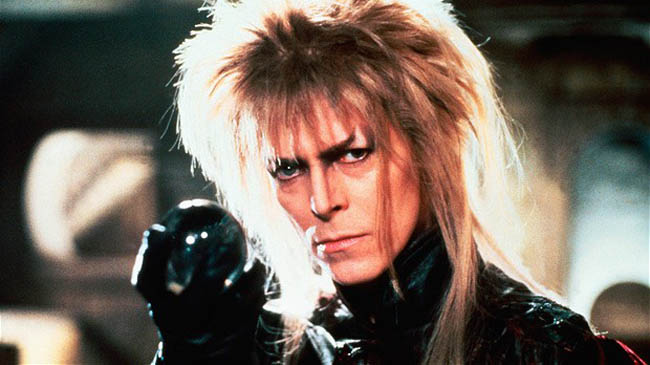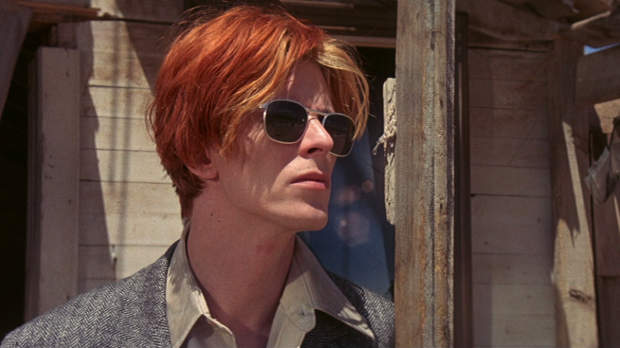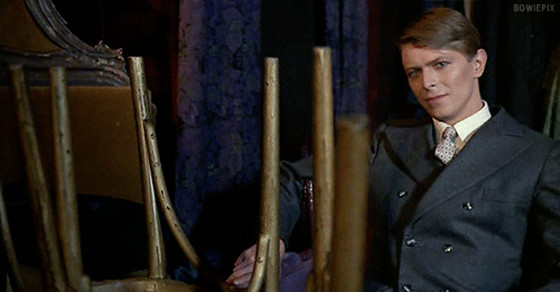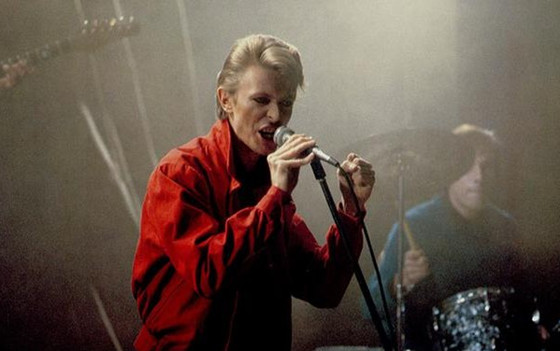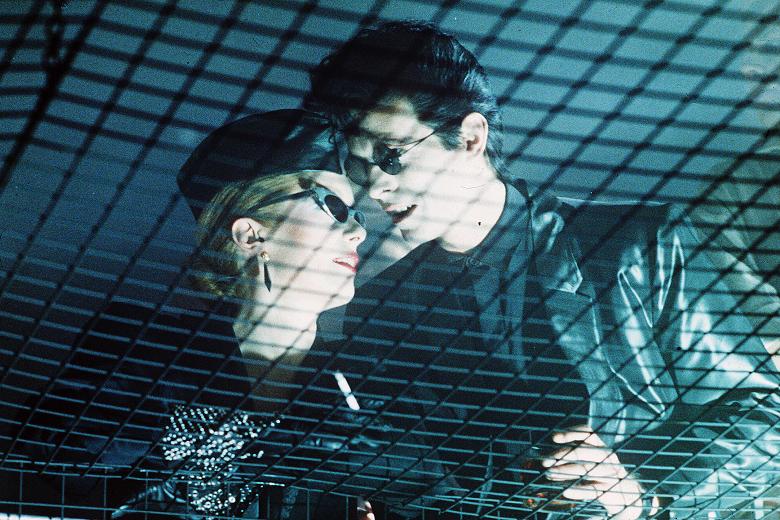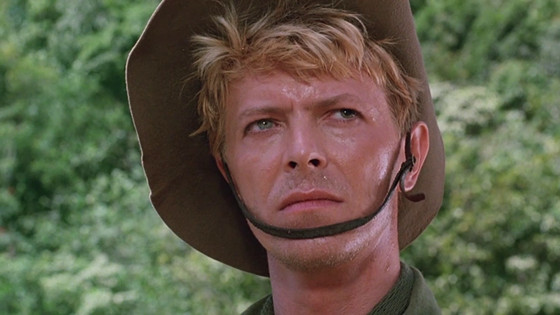When speaking of David Bowie, one of the most used adjectives to describe him and his career is “eclectic”. His versatility is fully shown not just in his musical production, but in his entire artistic life too. Bowie mutates his shape as years go by, and he himself is a catalyst for the changes.
Being the undisputed star of the seventies and the eighties, it’s easy to see how a certain kind of cinema became interested in using his face. His slender figure and peculiar features, symbolised by his iconic eyes (one pupil is bigger than the other, due to a punch received during a fight as a kid) made him the perfect character to embody the weird, the alien, the outcast.
During the nineties he started to slowly step aside, giving his contribution to the electronic scene and passing the baton. Even his appearances in movies became rarer and rarer, eventually for health problems too. Nevertheless, even in small roles and cameos, with a face marked by age (and drug abuse, too), his charisma and smooth charm stay unaltered.
He has been able to work with the best worldwide directors, from Scorsese to Oshima, from Lynch to Scott, from Landis to Nolan.
The films on this list are in chronological order.
1. The Man Who Fell To Earth (1976, Nicolas Roeg)
In 1976 Bowie is offered his first role in a movie. It’s the “Thin White Duke” era, Bowie is at the top of his controversial fame and Roeg chooses him to embody the main character of the film adaptation to the novel “The Man Who Fell To Earth” by Walter Tevis. Well, actually, it turns out to be the other way around: the Thin White Duke is born of one part of the extraterrestrial being of this film.
Bowie stars as Thomas Jerome Newton, a humanoid alien who came to Earth in order to collect water and bring it back to his drought-stricken planet. While on Earth, he disguises himself as a revolutionary inventor, using his alien technology in order to earn a great amount of money through patents and built a spaceship to travel back to his home planet. He slowly becomes addicted to human bad habits, such as alcohol, television and sex.
He’s eventually unmasked by the government and used as a test subject for medical experiment, and so prevented to rejoin his family on the home planet. Years pass, his former friends grow old aside from him and he slips into depression and alcoholism, as his home-planet family dies of starvation. Even when he finally frees himself and goes to back to a good living situation, he’s totally numb and detached from the world.
The character of Newton seem to be sewn on Bowie. In an interview, he admitted: “I actually was feeling as alienated as that character was. It was a pretty natural performance… a good exhibition of somebody literally falling apart in front of you. I was totally insecure with about 10 grams of cocaine a day in me. I was stoned out of my mind from beginning to end.”
Isolation, alienation, otherness are Newton’s main features: he feels different from humans because he is different, although he is easily absorbed by their same addictions and flaws.
Newton’s aesthetic is strongly connected to the Berlin era: the cover of the 1977 album “Low” is a still from the movie.
2. Just a Gigolo (1978, David Hemmings)
David Hemmings. You may remember him from cult movies such as Blow-Up and Deep Reed. What you may not know is that he also directed a bunch of films, including this “Schöner Gigolo, armer Gigolo”. The reason you may know about this film is that it features Marlene Dietrich’s last screen appearance.
Despite being intended as an ironic movie, it really stands out, so to speak, as a poor cinematic proof and a total mess. Bowie refers to it as “my 32 Elvis Presley movies rolled into one”.
Bowie plays a Prussian officer who, in the aftermath of the Great War, is unable to find an employment and is forced into becoming a gigolo. He eventually becomes friend with a Nazis sympathiser and ends up killed in a street fight in which he was not even involved.
This film was a failure in various aspects. First of all, it fails at its main goal, which was being ironic about the dawn of the Nazi Party: their representation is ridicule and grotesque but not as funny as you would expect to be. Actors seem to be there just to do the director a favour (and they probably were, according to some interviews).
Bowie’s character is hollow and never changes his features, even in pretty different conditions, and despite a supposed evolution of the character. That is to say, Bowie is so gorgeous and charming – even when he’s slightly subdued – that he makes you forget how mediocre this film is.
3. Christiane F. (1981, Uli Edel)
“Christiane F. – Wir Kinder vom Bahnhof Zoo”, based on the 1979 autobiographical book, became a very successful cult movie, due to a blunt and plain-spoken approach to the subject and the outrage caused by the young age of the characters. Bowie’s cameo as himself helped, of course, to boost the film’s commercial success. Although Bowie himself provides a small role in the movie, his presence lingers over the whole film.
Christiane is a young girl, living in West Berlin. She’s described as a fragile, bored girl, with a troubled family and a great passion for music, especially David Bowie. In fact, her most precious thing is a record collection, mostly made by Bowie records.
Her fascination for the Berlin musical scene will eventually bring her to The Sound, a modern disco, and into the spiral of drug abuse: starting from and LSD, she soon ends up becoming a heroin addict and she starts selling her body to the streets when she’s just 14 years old.
Like said before, Bowie is all over this film: first of all, of course, in the soundtrack, perfectly framed into those years; Christiane tries heroin for the first time when she’s attending his concert, in order to be accepted by the other kids; when in need for money, she sells her records, Bowie’s included. Needless to say, Bowie is one of the main symbols of that era, thanks to the Berlin trilogy and the glamourous references to drug use.
4. The Hunger (1983, Tony Scott)
Despite neither being a great commercial success, nor a perfect movie, “The Hunger” is considered a cult movie by its fans, thanks to its Gothic and esoteric aura.
Miriam is a millenarian vampire, who chooses special human beings to be her lovers and, in order to do so, she makes them immortal. The problem is that, in a variable amount of time, they eventually experience a sudden decay and enter into a sort of vegetative state, so that she “buries” them in her attic and moves on to a new lover.
The film starts when her actual lover, played by Bowie, starts ageing and Miriam tries to stop the process calling in for a gerontologist. Dr. Sarah Roberts shows up when it’s too late, but she’ll eventually become Miriam’s new lover.
At a certain point, the plot becomes pretty confusing and nonsense, but that is to say that the strength of this film is elsewhere: vampires’ design is minimal and stylish, mixing Egyptian cult with dark-wave fashion; the soundtrack is perfectly balanced and so is the cinematography; even the costumes are well designed. Bowie’s paleness and posh elegance make him perfect for the role, and, on the other hand, Deneuve and Sarandon are great as stylish lesbian vampires.
Almost twenty years later, Scott brothers produced an anthological TV series by the same name “The Hunger”. The host of the second season is David Bowie: he plays a mad artist who lives inside a self-made prison and introduces the stories to a psychotic fan. To be fairly honest,the series itself is, well, avoidable, although his character is interesting.
5. Merry Christmas Mr. Lawrence (1983, Nagisa Oshima)
1983 was a good year for Bowie, both for music and cinema: “Let’s Dance” is one of the most successful albums of his career, and 3 different movies starring him open in theaters: “The Hunger”, “Yellowbeard” and “Merry Christmas Mr. Lawrence”, from Japanese director Nagisa Oshima.
The film is set in a Japanese POW camp, in 1942. The title refers to one of the characters, the Colonel Lawrence, who works as a mediator between the English-speaker prisoners and the Japanese soldiers. The arrival of the eccentric Maj. Celliers will eventually ruin the fragile balance of the camp.
The main theme of the film is the clash of cultures between Orient and Occident: the Japanese soldiers have a militaristic and machistic mentality, whereas the British are weak, feminine and submissive.
The clash is embodied by the two main characters, Captain Yonoi and Major Celliers, both played by musicians (Ryuichi Sakamoto and David Bowie): Yonoi develops a morbid fascination over Celliers, but cannot let himself go because of his moral code; Celliers, despite being the prisoner, keeps Yonoi under his thumb.
It was said that Cellier’s features were modelled over Peter O’ Toole in Lawrence of Arabia and Yonoi’s over Yukio Mishima: this would give a further explanation to the homoerotic subtext of the film, in connection with the militaristic cruelty.
